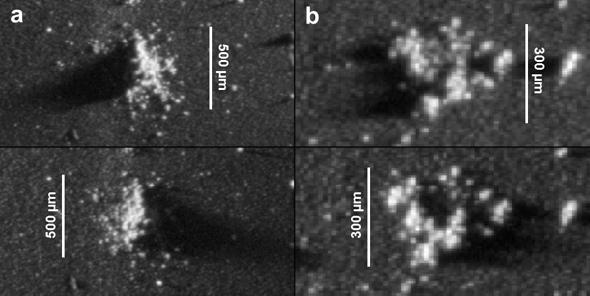I’ve seen a lot of stuff when it comes to space science and astronomy, and sure, I’m easily excited about it all … but still, it takes a lot to get me to boggle at something.
So this is me, boggling: This photo below shows grains of comet dust caught on the fly by the Rosetta spacecraft!

Photo by ESA/Rosetta/MPS for COSIMA Team MPS/CSNSM/UNIBW/TUORLA/IWF/IAS/ESA/ BUW/MPE/LPC2E/LCM/FMI/UTU/LISA/UOFC/vH&S
Yeah. That is very, very cool.
To be more accurate, they’re the remains of comet dust caught on the fly by the Rosetta spacecraft. OK, let me explain.
Comets are essentially dust, gravel, and rocks packed together by various types of ice. Generally speaking, we’re talking water, carbon dioxide, ammonia, carbon monoxide, and other things that are usually gaseous on Earth, but which are frozen in the depths of space.
Lots of comets orbit the Sun on long, elliptical paths, taking them out into the black, then back in closer to the Sun. As they near the Sun, the ice turns into a gas and blows off, and the other junk making up the comet are blown into space as well.
The Rosetta spacecraft is currently following along a comet, called 67P/Churyumov–Gerasimenko. It orbits the Sun once every 6.5 years, going out as far as Jupiter’s orbit (it’s called a Jupiter-family comet, in fact, a member of many comets with similar orbits), dropping down to just outside Earth’s orbit. As I write this, the comet is about 370 million kilometers from the Sun, a bit more than twice Earth’s distance, and still outside the orbit of Mars.
Still, that’s close enough that it’s already becoming active, and we see streams of gas flowing out of it. That means dust particles are coming off too. The thing is, “dust” is a somewhat generic term for tiny flakes of stuff that can have wildly different compositions. Rosetta is in the unique position to find out what 67/P’s dust is made of. So engineers and scientists gave it a shot.
That shot is COSIMA, the Cometary Secondary Ion Mass Analyser. Have you ever been in a snowfall and caught snowflakes on your tongue? That’s COSIMA, except it has a plate exposed to space instead of a tongue, and instead of snowflakes it’s catching, well, comet snowflakes.
When 67/P was still more than 450 million km from the Sun, and just 30 km from the comet, Rosetta caught several flakes of material from the comet. They impacted the plate at speeds of just 1–10 meters per second, roughly bicycling speed. The photo above shows two such specimens (the scale bars represent 500 and 300 microns, where a human hair is roughly 100 microns wide).
When they hit the plate they fragmented. If there had been lots of ice in them, they would have been held together better and wouldn’t have shattered, so right away this tells us the flakes were dry (not like Earth snowflakes at all). They also have a high sodium content, which matches lots of other interplanetary dust particles, particularly meteoroids that burn up in our atmosphere during meteor showers. We know those come from comets, so that checks out! This means we’ve actually found a sample of the parent material of meteor showers. Cool.
But what’s also interesting is what this means for the surface of the comet. These particles were emitted when the comet “turned on” again, getting close enough to the Sun to become active. Scientists think these grains were actually left over from the last time 67/P came ‘round the Sun. As the comet began to head away from the Sun, the flow of gas outward weakened, and wasn’t strong enough to lift dust away. That material then sat on the surface, and was lifted off as the outflow became strong once again a few months ago.
That outer mantle of older dust will be shed, and then more stuff deeper down will start to get flung away. When this happens the dust content may change, possibly showing us other types of material as well. Rosetta will be around for that; it will follow the comet for many more months as it gets to its closest point to the Sun (called perihelion). The comet should become more active, and we’ll get to investigate what lies beneath.
That to me is incredibly exciting. We know a lot about comets, but the devil’s in the details, and every comet is different. Heck, even a single comet changes a lot over the course of a single orbit, so by monitoring 67/P for several months, we’ll learn a lot about these weird beasts. And that’s the whole point.